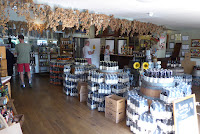Nestled in the quaint market town of
Tring in North Hertfordshire in the foothills of the Chilterns lies Tring
Brewery. Better known as Hertfordshire’s 2nd largest brewery (after
McMullens), it was established by Richard Shardlow in 1992, whom
revived the brewing industry in the area which had been dry since the last brewery
closed some sixty years before. Shardlow was already an experienced brewer having
worked for the likes of Greene King, Ruddles and Devenish; he was later joined
in 2000 by Andrew Jackson (formerly of Whitbread) whom together helped propel
the brewery into becoming of the major beer producers in Hertfordshire. Every fortnightly
Thursday and Saturday of the month, the brewery holds tours of their brewing facilities,
so seizing the opportunity I sought to give it a try. As we entered the
brewery, I struck by its appearance as it was merely a converted cow shed
purchased from the adjacent farm, repurposing buildings is a common feature in
modern day brewing. Access to the brewery was via the beer shop, on the left
there was a tasting bar where visitors could try samples of Colley’s
Dog (5.2%), Pale Four (4.6%), Citra (3.9%) and Dapper Deer (3.9%), their August monthly special. There were dozens
of packs of bottles containing various beers closely packed together throughout the vicinity,
along with other bits of memorabilia including Caps, Hoodies, Clay Beer Mugs, Coasters
and beer flavoured food such as Beef Jerky and Chutney (flavoured
with Death or Glory, 7.2%), along with a Hot Sauce (flavoured with Raven King, 5.5%). Every
nook and cranny was taken up, and was difficult to get around when crowded. By
the far right of the shop, was the Brewery Bar where visitors could obtain takeaway
bottles of various cask and keg beers, as well as Gift Packs; although there
was no seating area to try out beers, you can request a sample before deciding
to purchase.
As 2pm struck, a group of us were taken into the brewing area by PR director Jared Ward. The brewing area was closely packed with maturation tanks of various sizes, with the largest containing session beers destined for the cask trade, and smaller ones intended for monthly/ seasonal specials. Jared assembled the group of us, and began an extensive history lesson about the brewing of beer from it’s humble origins up to its mass industrialization in the 18th century. He then discussed about the various types of malt that the brewery uses, such as Pale Malt which they use as a base for all their beers due to its high fermentable content, Crystal Malt which they use for additional flavour and colouring (for amber/ brown coloured beers) and Chocolate Malt which they use to colour their darker ales such as Stout. I was intrigued to hear that they only use a small amount of this, which makes all the difference to the colour of the brew. To get a better idea of how malt works, we tried samples of Side Pocket (3.6%), Ridgeway Bitter (4%) and Tea Kettle Stout (4.7%), where Jared described how each of the three beers were developed with the various malts that give the beer styles of Golden Ale, Bitter and Stout their respective appearance and flavour profile. We then got to sniff and try some of the malt grains, the Pale Malt had a delicate flavour, whilst the Crystal Malt was slightly more pronounced with a touch of sourness, and the Chocolate Malt tasted like burnt toast which understandably gives Stouts and Porters their characteristic dark colour and roasty 'n' toasty flavours.
Following on from this, Jared informed us about the Hops the brewery uses that rounds off the flavours. He talked extensively about Hops, it’s importance as flavouring, keeping and sterilization properties, as well as the various hops the brewery uses that helps give their beers their distinctive flavours. One beer in particular he mentioned in detail was Raven King (5.5%) which we subsequently got to try, it was a punchy hazy IPA with a medley of tropical flavours and aromas wafting through, made possible through the likes of Mosaic and Citra hops thrown into the mix. We then had the chance to sniff these two hop varieties, with the latter being distinctly Citrussy in it’ aroma which helps give this beer its distinctive edge. Jared then moved us along to the mighty Mash Tun where all their beers are developed from. The malt grains are mashed and boiled, then the wort is filtered and drained, and the spent grain is donated for use in animal feed in the neighbouring farm. The wort is transferred to the boiler, where hops are added prior to the end of the boil, before the wort is sent to a fermentation vessel. Jared then took us to one of those vessels, where yeast is added to ferment with the sugars in order to give off alcohol and carbon dioxide which gives out natural carbonation. The brewery uses the same yeast for all their beers, which they constantly have to use 24/7 in order to keep it viable. Even when they suffered a power cut during lockdown, they had to keep the brewing process going using emergency generators and invertedly created an Imperial Stout version of their Tea Kettle Stout (4.7%), which measured at a hefty 11% ABV, which was never has been released commercially at the time of writing.










No comments:
Post a Comment